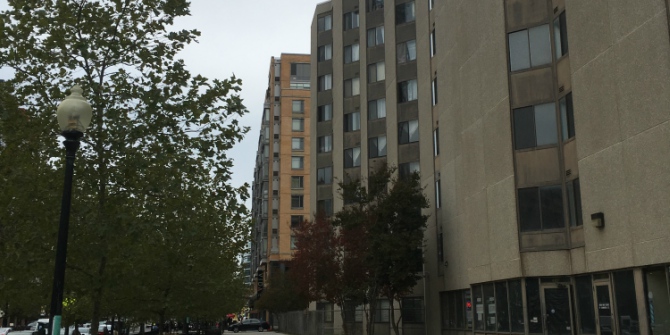 American cities collectively hold about $3.7 trillion in bonds, which have historically been used to fund capital expenditures. In recent years, however, bond issuers have been strategically leveraging municipalities’ debts via derivatives, which have introduced systemic risk into the municipal finance system. L. Owen Kirkpatrick writes that the Trump administration’s stated desire to dismantle the Dodd-Frank Act may speed up the current cycle of financial instability, and lead to more financial pain and misery for US cities.
American cities collectively hold about $3.7 trillion in bonds, which have historically been used to fund capital expenditures. In recent years, however, bond issuers have been strategically leveraging municipalities’ debts via derivatives, which have introduced systemic risk into the municipal finance system. L. Owen Kirkpatrick writes that the Trump administration’s stated desire to dismantle the Dodd-Frank Act may speed up the current cycle of financial instability, and lead to more financial pain and misery for US cities.
On February 3, 2017, President Donald Trump signed an executive order directing the US Treasury to begin dismantling the financial regulations established by the 2008 Dodd-Frank Act. On the surface, the order may seem to have little to do with the affairs of US cities. But cities are now deeply reliant on finance markets to pay for the things that they need. In 2011, the US municipal bond market encompassed over one million bonds worth $3.7 trillion, issued by almost 50,000 different municipal entities. Being so closely tethered to capital markets means that cities are now profoundly impacted by changes in the financial sector.
Local officials, of course, have always needed access to long-term debt for the upfront capital expenditures required for large-scale municipal systems. In the mid-twentieth century, the municipal debt market was a rather staid and sedate place, made up of low-risk, long-term debt instruments. This debt took two basic forms: (1) low-risk “general obligation bonds” backed by the taxing power (“full faith and credit”) of the issuing municipality, and (2) “revenue bonds” that are backed by dedicated revenue streams (such as toll receipts), which do not require electoral approval nor count against local debt limits.
In the 1970s and 1980s, municipal finance began changing as arcane, high-risk products and practices gained popularity. These profitable but unstable instruments flourished in an under-regulated environment. While the federal government sets the parameters of municipal securities via tax law, they are otherwise only lightly monitored. As the Securities and Exchange Commission (SEC) reports, “[d]espite its size and importance, the municipal securities market has not been subject to the same level of regulation as other sectors of the US capital markets.” The passage of the Tax Reform Act of 1986 changed the structure of the market, but not the level of regulation or oversight. After its passage, new practices emerged which ultimately encouraged municipal issuers to strategically leverage their bond proceeds.
The strategic leveraging of municipal debt takes the form of financial derivatives: interest-rate swaps, variable-rate demand obligations, floaters/inverse floaters, auction-rate instruments, and the like. If there was any doubt as to the regulatory status of municipal derivatives, the Commodity Futures Modernization Act (2000) ruled that they were exempted from federal rules governing securities, an exemption that would also preempt the field of state regulations. Municipal derivatives had three key things in common. First, they promised more profits for Wall Street firms than long-term, fixed-rate bond issues. Second, due to the lack of oversight, they could be aggressively pitched to local officials. And, lastly, they promised impressive returns for municipal issuers by capturing the spread between long- and short-term interest rates.
Derivatives also introduced systemic risk into the municipal finance system. As more US cities made the bet that interest rates would remain low, vulnerability spread, and when interest rates rose, it triggered a crisis from which some cities are still recovering. Diminished revenues and a rash of speculative municipal debt that “went bad” in the aftermath of the crisis tightened the fiscal noose. When Detroit filed for bankruptcy in 2013 it became the twenty-eighth US city to do so since the onset of the crisis. Numerous quasi-public agencies (local and regional authorities, public corporations, and special districts) face similar pressures. For better or worse, urban fortunes are now tied to finance markets.
Cyclical volatility and the three stages of municipal finance
This linkage has a destabilizing effect on municipal finance, but the instability is not random. American economist and financial theorist, Hyman Minsky (1919-1996), posits that volatility in financial markets is cyclical. According to Minsky’s financial instability hypothesis (FIH), the cycle begins during boom times, when a heady sense of optimism contributes to the spread of increasingly speculative debt structures, whereby firms more aggressively leverage debt for the purposes of investment and expansion. This speculative activity causes the price of financial assets to increase, which (temporarily) rewards and legitimizes risky debt leverage practices. But this is a highly unstable form of growth and the cycle ultimately ends in crisis.
Minsky specifies three stages of financial activity, which can apply to the world of municipal finance. The safest liability structure is employed by “hedged” financing units, which honor their outstanding debt, both interest and principal, through normal operating revenues. For cities, this consists of intergovernmental grants, “pay as you go” financing structures, and long-term, low-risk debt vehicles (general obligation bonds).
The second, “speculative,” type of debt structure is employed by units whose revenues can pay the interest on outstanding debt, but cannot pay down the principal (which is refinanced or rolled over). This may be the case in cities that make big capital investments in future development (e.g. stadium), but where revenues fail to meet projections. In such cases, officials may float short-term debt, in pseudo-continuous fashion, to meet the operational requirements of the city.

The final category is “Ponzi” financing, in which revenues cannot meet debt obligations, neither interest nor principal. Cities sell assets, or undertake high-risk financing strategies (e.g. derivatives), which seek to leverage municipal debt to pay expenses. The three stages are marked by an increasing reliance on capital markets – while hedge financing is “impervious” to financial volatility, speculative and Ponzi are highly “vulnerable… to changing market conditions.”
Minsky believed that this pattern tends to reset and repeat. Depression conditions will persist until they are addressed by monetary intervention from a “lender of last resort.” Specifically, it is up to the Federal Reserve to “pick up the pieces when things go wrong,” thus punching society’s ticket for another boom-bust financial ride. By injecting liquidity into the system, central banks ensure the integrity of “too big to fail” financial institutions and establish a floor under asset prices as institutional investors unwind their leveraged positions.
But here we encounter a core contradiction: every time the central bank intervenes, it legitimizes risky activity. “[B]y validating the past use of an instrument,” Minsky explains in Stabilizing an Unstable Economy (1986), “an implicit guarantee of its future value is extended.” This creates a moral hazard in which “the protected multibillion-dollar banks… can bias their asset and liability innovations toward instruments that can compromise their liquidity and equity and expect to be protected.”
One way in which this central difficulty can be mitigated is through a revitalized regulatory apparatus that sets well-defined limits on the range of acceptable financial activities. “A tighter regulatory regime may be… a way of getting around the moral hazard,” argues Minsky, thereby slowing the progression to the next crisis. For this to be achieved, it is necessary to rein in destabilizing financial instruments and liability structures. Ideally, Minsky concludes, regulatory restructuring should entail “the creation of new economic institutions which constrain the impact of uncertainty.”
Dodd-Frank and municipal securities
In the case of the municipal securities crisis, the immediate recovery effort was fueled by a broad consensus concerning the need for significant reform, itself unsurprising given the nature and scale of the crash. This effort resulted in the 2010 Dodd-Frank Act, which impacted municipal securities in several key ways.
While the municipal market had been exempted from previous rounds of regulation it now fell largely under the purview of the Securities and Exchange Commission (SEC). Suddenly, the SEC was no longer “toothless” in the municipal arena. Secondly, steps were taken to decrease the number of “unregulated market participants” dealing in municipal securities and derivatives. This involved expanding the regulatory reach of the Municipal Securities Rulemaking Board (MSRB) to include financial advisors. This set industry standards for advisors designed to curb problems associated with “role-switching” and graft that plagued the pre-crisis market.
The Dodd-Frank Act certainly wasn’t perfect. According to the SEC itself, the Act spread regulatory responsibility across several agencies rendering enforcement uneven and incomplete. Municipal finance remained a cat-and-mouse game, in which bankers and hedge fund managers try to innovate their way around the latest regulatory standards. On the other hand, however, it has also been said that the 2008 crisis launched a regulatory “revolution” in the municipal bond market. Extensive and ongoing fraud investigations, heightened regulatory scrutiny, new administrative structures, and new transparency, disclosure, and ratings standards represented substantial efforts to regulate municipal capital markets.
The cycle is pivoting
The immediate post-crisis period is a pivotal point in the cycle – the moment when political and economic repair operations are intellectually conceived and institutionally implemented. Ideally, for Minsky, this process results in a reinvigorated regulatory apparatus undergirded by deep political and social-psychological shifts in how we perceive and interact with markets. In a best-case scenario, the cycle is essentially reset to stage one, paving the way for another sustained period of growth. Of course there is no guarantee that repair operations will be successful; numerous obstacles threaten to prevent or pervert the ideal response to crisis.
There is also an important timing aspect at play. Immediately following a crisis, with the memory of lost fortunes still fresh, investors, lenders, and policymakers are cautious. But as those memories fade, the “lure of a bonanza” becomes more enticing and regulations are relaxed. But therein lays the rub. “Unless the regulatory apparatus is extended,” warns Minsky, “the success enjoyed by these interventions in preventing a deep depression will be transitory; with a lag, another situation requiring intervention will occur.”
In the US, the financial instability cycle has sped up and periods of inter-crisis stability are now fleeting. The Trump administration’s dismantling of the Dodd-Frank Act less than seven years after its passage is powerful evidence of this trans-cyclical acceleration. For a time, Wall Street firms and other market participants may indeed get swept up in the exuberance that attends the latter stages of the financial cycle. But this optimism too will be fleeting and the cycle will end, once again, in crisis and despair for US cities.
This article is based on the paper, “The New Urban Fiscal Crisis: Finance, Democracy and Municipal Debt” in Politics & Society.
Featured image credit: Ann Millspaugh (Flickr, CC-BY-SA 2.0)
Please read our comments policy before commenting.
Note: This article gives the views of the author, and not the position of USAPP – American Politics and Policy, nor the London School of Economics.
Shortened URL for this post: http://bit.ly/2lV2kbl
_________________________________
 Lucas Owen Kirkpatrick – Southern Methodist University
Lucas Owen Kirkpatrick – Southern Methodist University
Lucas Owen Kirkpatrick is an Assistant Professor of Sociology at Southern Methodist University in Dallas, Texas. His current work is focused on the political and socioeconomic geography of urban growth and decline.






